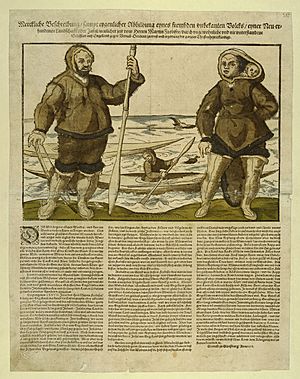Edward Dodding facts for kids
Quick facts for kids
Dr
Edward Dodding
|
|
|---|---|
| Born | c. 1540 Westmorland, England
|
| Died | April 1592 (aged 51–52) |
| Nationality | English |
| Education | Trinity College, Cambridge |
| Years active | 1572–1592 |
| Known for | Post-mortem of Kalicho |
| Medical career | |
| Profession | Physician |
Edward Dodding (born around 1540 – died April 1592) was an English doctor. He is known for performing a special examination, called a post-mortem, on a man named Kalicho. Kalicho was one of three Inuit people who sadly died shortly after being brought to England in 1577. They were brought by an explorer named Martin Frobisher.
Dodding's notes from Kalicho's post-mortem were very detailed for his time. They give us a good look into what doctors knew back then. They also show how the English viewed people from other cultures.
Contents
Early Life of Edward Dodding
Edward Dodding was born in the English county of Westmorland around the year 1540. He went to Trinity College at the University of Cambridge. He earned his first degree (BA) in 1562 or 1563. Later, he received his master's degree (MA) in 1566.
Dodding's Medical Career
In 1573, Dodding received a special permission to practice medicine from the University of Cambridge. He became a full doctor (M.D.) in 1576. The next year, he was working as a doctor in Bristol.
On June 25, 1584, he became a member of the important Royal College of Physicians. He continued to practice medicine until he passed away in 1592.
The Story of Kalicho, Arnaq, and Nutaaq
In 1577, the explorer Martin Frobisher brought three Inuit people to England. This happened after his second trip to find the North West passage. The group included a man named Kalicho, a woman named Arnaq, and Arnaq's young son, Nutaaq.
Sadly, all three died soon after arriving in Bristol in October 1577. It's possible Kalicho and Arnaq didn't know each other before they were captured. The names used for them in England might not have been their real Inuit names.
When Kalicho became very sick, Dr. Dodding first suggested a treatment called bloodletting. This was a common practice then. However, Kalicho refused this treatment. In the last hour of Kalicho's life, Dodding noticed his speech, appetite, and pulse were getting weaker. But near the very end, Kalicho started talking clearly again. He even sang a song that people had heard when he was first taken from Baffin Island. His last words were a phrase he had learned in England: "God be with you." Kalicho died on November 7, 1577, about a month after he arrived in England.
Dr. Dodding performed a post-mortem examination on Kalicho in Bristol on the same day he died. He found broken ribs that had not healed. He also noted a lung injury and infection, likely from Kalicho being thrown to the ground during his capture. Dodding also observed Kalicho's large stomach. He thought this was because Kalicho had been fed a lot, perhaps too much, by the English.
Dodding also found signs of a brain injury. In a very unusual step for doctors at that time, he wrote about Kalicho's fear of the English. He noted that Kalicho usually hid this fear behind a cheerful face. This report was written in Latin on November 8. It was later translated into English three times. Historians say it was "unusually complete" for its time.
Dr. Dodding made Arnaq watch Kalicho's burial at St Stephen's Church in Bristol. He also showed her human bones that had been recovered. This was to prove to her that the English were not cannibals. Dodding wasn't sure how to understand Arnaq's reaction. He thought she might be very strong and calm, or simply not caring.
Soon after, Arnaq also became sick, likely with measles. She died and was buried at St Stephen's on November 12, 1577. A nurse was hired to take the baby Nutaaq to London. The plan was for Queen Elizabeth to see him. But Nutaaq also died soon after arriving in London, probably from measles, before the Queen could meet him.
Dodding's detailed notes, along with paintings and other accounts from that time, help us understand medicine in the 1500s. They also show how the English viewed people from other lands. Dr. Dodding was well-trained and did not seem cruel. His notes are a valuable historical record.
Death
Edward Dodding was buried in London at St Dunstan-in-the-West on April 11, 1592.


